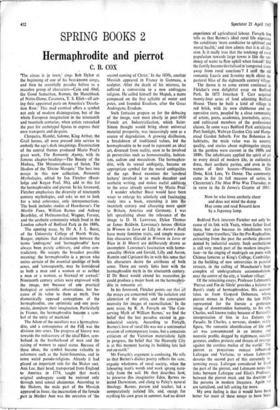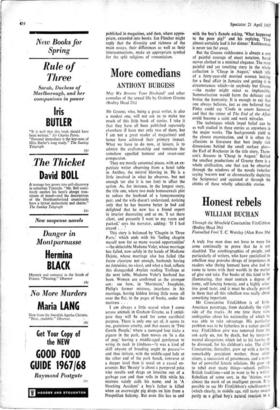Hermaphrodite and pierrot SPRING BOOKS 2
C. B. COX
The circus is in town,' sings Bob Dylan at the beginning of one of his best-known songs, and then he scornfully parades before us a macabre group of characters—Cain and Abel, the Good Samaritan, Romeo, the Hunchback of Notre-Dame, Casanova, T. S. Eliot—all act- ing their appointed parts on America's 'Desola- tion Row.' This mad carnival offers a symbol not only of modern disintegration, but of the whole European imagination in the nineteenth and twentieth centuries, when artists ransacked the past for archetypal figures to express their own transports and despairs.
Cleopatra, Hamlet, Salome, King Arthur, the Grail heroes, all were pressed into service to embody the age's dark imaginings. Examination of the central themes produced Mario Praz's great work, The Romantic Agony, with its famous chapter-headings—The Beauty of the Medusa, The Metamorphoses of Satan, The Shadow of the 'Divine Marquis.' The best two essays in this new collection, Romantic Mythologies, edited by Ian Fletcher (Rout- ledge and Kegan Paul, 50s), add to this list the hermaphrodite and pierrot. In his foreword, Fletcher emphasises the diversity of nineteenth century mythologies, and asks us not to look for a total coherence, only interconnections. The book includes studies of Hawthorne's The Marble Faun, William Barnes and Aubrey Beardsley, of Hofmannsthal, Wagner, Forster, and the aesthetic community which lived in the London suburb of Bedford Park in the 1880s.
The opening essay, by Dr A. J. L. Busst, of the University College of North Wales, Bangor, explains that distinctions between the terms 'androgyne' and `hermaphrodite' have always been purely arbitrary, and often con- tradictory. He accepts the broadest possible meaning; the hermaphrodite -is a person who unites certain of the essential qualities of both sexes, and 'consequently, may be ionSiClered as both a man and a woman or as neither a man or a woman, as bisexual -or asexual' Nineteenth century artists were engrossed with the image, not because of any practical biological or scientific observations, but be- cause of its value to them as myth. Two diametrically opposed conceptions of the hermaphrodite, one optimistic and one pessi- mistic, dominate their imagination. Particularly in France, the hermaphrodite becaMe a sym- bol of the unity of mankind.
The Adam of the occultists was a hermaphro- dite, and a consequence of the Fan was the division into sexes. The progress of history was towards the rediscovery of the ideal Eden, sym- bolised in the brotherhood of man and the raising of women to equal status. Because of these ideas, the symbol became valuable to reformers such as the Saint-Simonites, and to some weird pseudo-religions. Already it had played an important role for the Shaker sect. Ann Lee, their head, transported from England to America in 1774, taught that man's original androgyny could be restored only through total sexual abstinence. According to the Shakers, the male part of the Messiah appeared in Jesus; the incarnation of the female part in Mother Ann was the occasion of 'the
second coming of Christ.' In the 1830s, another Messiah appeared in France in Ganneau, sculptor. After the death of his mistress, he suffered a conversion to a new androgyne. religion. He called himself the Mapah, a name composed on the first syllable of mater and pater, and founded Evadism, after the Great Androgyne, Evadam.
Such fantasies prepare us for the debasing of the image, seen most clearly in post-1850 ' French art. Industrialisation, which Saint- Simon thought would bring about universal material prosperity, was increasingly seen as a source of degradation. A growing disillusion, a breakdown of traditional values, led the hermaphrodite to be used to represent an ideal art, divorced from reality, soon to be involved in perversities such as homosexuality, lesbian- ism, sadism and masochism. The hermaphro- dite, with its sexual ambiguity, became' an appropriate symbol for the moral ambiguities of the age. Busst examines the 'cerebral lechery' involved in so much decadent and aesthetic writing, and makes useful additions to the areas already covered by Mario Prez:
I wonder whether Busst would- have been wiser to enlarge his scholarly and fascinn4., g study into a book, extending it into 'the twentieth century and allocating more spatet to Britain, America and Germany. I was left speculating about the relevance of the image to D. H. Lawrence, Dylan Thomas or James Baldwin. Lawrence's heroes (Birkin in Women in Love or Lilly in Aaron's Rod) have many feminine traits, and simple mascu- line characters (Gerald, in Women in Love or Rico in' St Mawr) are deliberately drawn as incomplete. Lawrence's fascination with homo- sexuality (Birkin and Gerald, Lilly and Aaron, Ramdn and Cipriano) fits in with this sense that his characters desire the attributes of both sexes. There are surely links here with the hermaphrodite myth in the nineteenth century. - If Dr Busst would extend his researches .be could produce a major book on the hermaphro- dite in romantic art.
In his foreword, Fletcher points out that all the essays are concerned with 'the isolation and alienation of the artist, and the consequent necessity for images of reconciliation.' In the next essay, by R. A. Forsyth on `The Con- serving Myth of William Barnes,' we find the belief that the lost paradise existed industrial society. According to Forsyth, Barnes's love of rural life was not a sentimental evasion of contemporary issues, but a conscious criticism of the Victorian materialistic faith in progress, the belief that `the Heavenly City is at this moment having its building lots laid out on earth.'
Mr Forsyth's argument is confusing. He tells us that Barnes's dialect poetry reflects the sane, organic wholeness of rural society, when the labouring man's words and work sprang nani, rally from the soil. He then describes hoW, to preserve this imaginative Eden, Barnes' re.. jected Darwinism, and clung to Paley's natural theology. Barnes, parson and teacher, led a comparatively isolated life, and, except for scything his own grass in summer, had no direct experience of agricultural labour. Forsyth first tells us that Barnes's ideal rural life expresses the conditions 'most conducive to spiritual and moral health,' and then admits that it is all illu- sion. Is it really true that the tendency of rural population towards large towns is like the ten- dency of water to flow uphill when forced? Did the family becomedevitalised in 'congested slums away from rural sanctions'? I sniff the old romantic Leavis and Scrutiny myth about the pastoral bliss of the eighteenth century village.
The theme is to some extent continued in Fletcher's own delightful essay on Bedford Park. In 1875 Jonathan T. Carr acquired twenty-four acres of land adjoining Bedford House. There he built a kind of village in red brick, with its own clubhouse and co- operative store, peopled by a close community of artists, poets, academics, journalists, actors. and cultivated members of the professional classes. In some ways Bedford Park anticipated Port Sunlight, Welwyn Garden City and Hamp- stead Garden Suburb. For the Bohemian in- habitants, the -main value was its country quality, and stories about nightingales' singing in the gardens were current in the 1880s and 1890s. The inhabitants applied' the spirit of art to every detail of modern life, in outlandish dress, their •aesthetic parties, and even in the names of their houses—Pleasaunce, Elm Dene, Kirk Lees, Ye Denne. The community came in for its full measure 'of satire, in Chesterton's The Man Who Was Thursday, or in verse in the St James's Gazette of 1881: Now he who loves aesthetic cheer and does not mind the damp May come and read Rossetti here by a Japanesy lamp.
Bedford Park interests Fletcher not only be- cause of its link with Yeats, whose father lived there, but also because its inhabitants were typical lime-travellers,' like the Pre-Raphaelites, extracting from the past the aesthetic pleasure denied by industrial society. Such aestheticism is still very much part of the modern imagina- tion—in the singing of madrigals on punts with Chinese lanterns at King's College, Cambridge, in the building of new universities in pastoral retreats, in the calling of Manchester's huge complex of undergraduate accommodation, near the. centre of the city, a 'student village.'
Of the remaining essays, Professor Lehmann's Pierrot and Fin de Siècle' provides a balance to BusWs study of hermaphrodites. His account takes us from Gaspard Debureau, whose pierrot mimes in Paris after the late 1820s represented for the literate a grotesque image of downtrodden humanity, to his son, Charles, well known today because of Barrault's interpretation of him in Les Enfants do Paradis. In Charles, a nervous, slender, sickly figure, `the romantic identification of life and art was consummated in an intense and neurotic profile, dogged by nightmare, suicidal gestures, endless protests and threats of revenge against the careless malice of the world' The pierrot as 'precarious outcast influenced Laforgue and Verlaine, to whom Lehmann devotes 'the second part of this extremely in- teresting essay. Laforgue considered he lived the part of thenierrot, and Lehmann notes the links between Laforgue and Eliot's Prufrock. between the pierrot mask and the doctrine of the persona in modern literature. Again we are tantalised, and left asking for more. My own feeling is that it would have been better for most of these essays to have been
published in magazines, and then, where appro- priate, extended into books. Ian Fletcher might reply that the diversity and richness of the main essays, their differences as well as their interconnections, make an appropriate symbol for the split religions of romanticism.







































 Previous page
Previous page